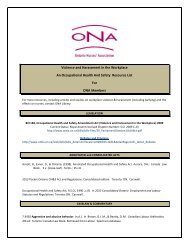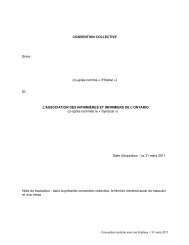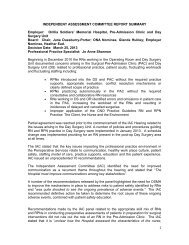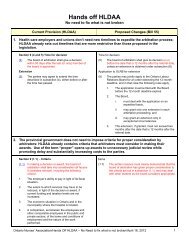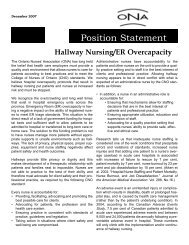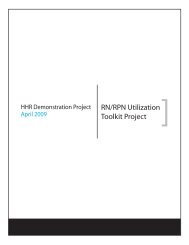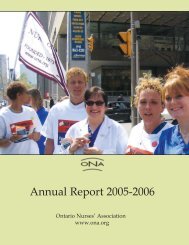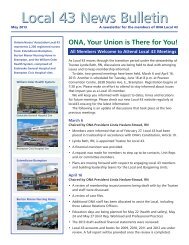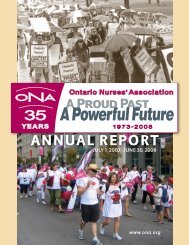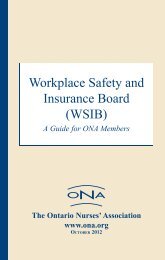RN and RPN Environment Professional Practice Teleconnect
RN and RPN Environment Professional Practice Teleconnect
RN and RPN Environment Professional Practice Teleconnect
You also want an ePaper? Increase the reach of your titles
YUMPU automatically turns print PDFs into web optimized ePapers that Google loves.
PRACTICE guideline<br />
<strong>RN</strong> <strong>and</strong> <strong>RPN</strong> <strong>Practice</strong>: The Client, the Nurse<br />
<strong>and</strong> the <strong>Environment</strong><br />
Table of Contents<br />
Introduction 3<br />
Guiding Principles 3<br />
Legal Scope Of <strong>Practice</strong> 3<br />
Nurses’ Accountability 4<br />
The Three-Factor Framework 5<br />
Client factors 5<br />
Nurse factors 7<br />
<strong>Environment</strong> factors 11<br />
Appendix 12<br />
Glossary 14<br />
References 16
vision<br />
Leading in regulatory excellence<br />
mission<br />
Regulating nursing in the public interest<br />
<strong>RN</strong> <strong>and</strong> <strong>RPN</strong> practice: The Client, the Nurse <strong>and</strong> the <strong>Environment</strong> Pub. No. 41062<br />
ISBN 978-1-897308-95-0<br />
Copyright © College of Nurses of Ontario, 2011.<br />
Commercial or for-profit redistribution of this document in part or in whole is prohibited except with the written consent of CNO. This<br />
document may be reproduced in part or in whole for personal or educational use without permission, provided that:<br />
• Due diligence is exercised in ensuring the accuracy of the materials reproduced;<br />
• CNO is identified as the source; <strong>and</strong><br />
• The reproduction is not represented as an official version of the materials reproduced, nor as having been made in affiliation with,<br />
or with the endorsement of, CNO.<br />
First Published June 1996 as A Guide to Health Care Consent <strong>and</strong> Substitute Decisions Legislation for <strong>RN</strong>s <strong>and</strong> <strong>RPN</strong>s<br />
Replaces Publication Published 1997, Determining Appropriate Category of Care Provider<br />
First Published July 2002 as <strong>Practice</strong> Expectations: A Guide for the Utilization of <strong>RN</strong>s <strong>and</strong> <strong>RPN</strong>s, Reprinted December 2002,<br />
Revised for Web June 2003, Reprinted January 2004, December 2005, May 2008. Updated June 2009.Revised Dec 2011 as <strong>RN</strong> <strong>and</strong> <strong>RPN</strong> <strong>Practice</strong>:<br />
The Client, the Nurse <strong>and</strong> the <strong>Environment</strong>, this document replaces Utilization of <strong>RN</strong>s <strong>and</strong> <strong>RPN</strong>s.<br />
Additional copies of this booklet may be obtained by contacting CNO’s Customer Service Centre at 416 928-0900<br />
or toll-free in Ontario at 1 800 387-5526.<br />
College of Nurses of Ontario<br />
101 Davenport Rd.<br />
Toronto ON M5R 3P1<br />
www.cno.org<br />
Ce fascicule existe en français sous le titre : L’exercice de l’IA et de l’IAA : l’infirmière, le client et l’environnement, n o 51062
<strong>Practice</strong> Guideline<br />
3<br />
<strong>Practice</strong> guidelines are documents that help nurses<br />
underst<strong>and</strong> their responsibilities <strong>and</strong> legal obligations<br />
to enable them to make safe <strong>and</strong> ethical decisions when<br />
practising. They provide an outline of professional<br />
accountabilities <strong>and</strong> relevant legislation.<br />
– College of Nurses of Ontario<br />
Introduction<br />
Nursing is a profession that is focused on<br />
collaborative relationships that promote the best<br />
possible outcomes for clients. These relationships<br />
may be interprofessional, involving a variety of<br />
health care professionals working together to deliver<br />
quality care within <strong>and</strong> across settings; or it may be<br />
intraprofessional, with multiple members of the<br />
same profession working collaboratively to deliver<br />
quality care within <strong>and</strong> across settings.<br />
This document focuses on three factors — the<br />
client, the nurse <strong>and</strong> the environment — to support<br />
nurses in making decisions that are specific to their<br />
intraprofessional responsibilities when providing<br />
client care.<br />
These three factors have an impact on decisionmaking<br />
related to care-provider assignment (which<br />
nursing category (Registered Nurse [<strong>RN</strong>] or<br />
Registered Practical Nurse [<strong>RPN</strong>]) to match with<br />
client needs), as well as the need for consultation<br />
<strong>and</strong> collaboration among care providers.<br />
Many of the concepts in this document apply<br />
to all nurses; however, references to nurses or<br />
intraprofessional care in this document refer only<br />
to <strong>RN</strong>s <strong>and</strong> <strong>RPN</strong>s — Nurse Practitioners are not<br />
included in this document because the complexity of<br />
client care does not define their involvement in care.<br />
This document replaces the Utilization of <strong>RN</strong>s <strong>and</strong><br />
<strong>RPN</strong>s practice guideline.<br />
Purpose<br />
The purpose of this document is to:<br />
■<br />
help nurses, employers <strong>and</strong> others make effective<br />
■<br />
■<br />
■<br />
decisions about the utilization1 of individual<br />
nurses in the provision of safe <strong>and</strong> ethical care<br />
outline expectations for nurses within the threefactor<br />
framework, highlighting the similarities<br />
<strong>and</strong> differences of foundational nursing<br />
knowledge <strong>and</strong> its impact on autonomous<br />
practice2<br />
highlight nurses’ accountabilities when<br />
collaborating with one another<br />
identify attributes of practice environments<br />
that facilitate nursing assignments, enhance<br />
collaboration <strong>and</strong> lead to improved client<br />
outcomes <strong>and</strong> public protection.<br />
Guiding Principles<br />
The following principles guide nurses’ practice<br />
expectations <strong>and</strong> are the basis for decision-making<br />
when working within the intraprofessional team:<br />
■<br />
The goal of professional practice is to obtain the<br />
best possible outcome for clients.<br />
■<br />
<strong>RN</strong>s <strong>and</strong> <strong>RPN</strong>s study from the same body of<br />
nursing knowledge. <strong>RN</strong>s study for a longer<br />
period of time, allowing for greater foundational<br />
knowledge in clinical practice, decision-making,<br />
critical thinking, leadership, research utilization<br />
<strong>and</strong> resource management. As a result of these<br />
differences, the level of autonomous practice of<br />
<strong>RN</strong>s differs from that of <strong>RPN</strong>s.<br />
■<br />
The complexity of a client’s condition influences<br />
the nursing knowledge required to provide the<br />
level of care the client needs. A more complex<br />
client situation <strong>and</strong> less stable environment create<br />
an increased need for consultation <strong>and</strong>/or the<br />
need for an <strong>RN</strong> to provide the full range of care<br />
requirements.<br />
■<br />
Respecting <strong>and</strong> underst<strong>and</strong>ing the expectations<br />
<strong>and</strong> contributions of the health care team<br />
facilitates appropriate utilization of nurses,<br />
enhances collaboration <strong>and</strong> leads to improved<br />
client outcomes.<br />
Legal Scope Of <strong>Practice</strong><br />
The Regulated Health Professions Act, 1991 (RHPA)<br />
<strong>and</strong> the Nursing Act, 1991 provide<br />
1 For<br />
the purpose of this document, utilization refers to determining the appropriateness of assigning client care to nurses, <strong>and</strong> of nurses<br />
accepting responsibility for client care.<br />
2 Bolded words are defined in the glossary on page 14.<br />
College of Nurses of Ontario <strong>Practice</strong> Guideline: <strong>RN</strong> <strong>and</strong> <strong>RPN</strong> practice: The Client, the Nurse <strong>and</strong> the <strong>Environment</strong>
4<br />
<strong>Practice</strong> Guideline<br />
the legislative framework for nursing practice.<br />
Components of the legislative framework are a<br />
scope of practice statement <strong>and</strong> a list of controlled<br />
acts authorized to nursing.<br />
Controlled acts are activities that are considered<br />
to be potentially harmful if they are performed<br />
by unqualified persons. A profession’s legal scope<br />
of practice is determined by its scope of practice<br />
statement <strong>and</strong> the controlled acts it has the<br />
authority to perform.<br />
Members of regulated health professions are<br />
authorized to perform specific controlled acts<br />
appropriate to their profession’s scope of practice.<br />
Having the authority to perform a procedure<br />
does not necessarily mean that the individual is<br />
competent or that it is appropriate for the individual<br />
to perform the procedure.<br />
i. Nursing’s Scope of <strong>Practice</strong> Statement<br />
The scope of practice statement describes in a<br />
general way what the profession does <strong>and</strong> the<br />
methods that it uses; it refers to the profession as a<br />
whole, rather than what any individual can do.<br />
The scope of practice statement for nursing states:<br />
The practice of nursing is the promotion of health<br />
<strong>and</strong> the assessment of, the provision of, care for, <strong>and</strong><br />
the treatment of, health conditions by supportive,<br />
preventive, therapeutic, palliative <strong>and</strong> rehabilitative<br />
means in order to attain or maintain optimal function.<br />
<strong>Practice</strong> is so broad <strong>and</strong> varied that no one nurse<br />
is expected to be competent to carry out all the<br />
activities within the legal scope of practice; hence,<br />
the notion of “full scope of practice” is unlikely.<br />
ii. Controlled Acts Authorized to Nurses<br />
The Nursing Act, 1991 authorizes nurses to perform<br />
three controlled acts. They are:<br />
■<br />
performing a prescribed procedure below the<br />
■<br />
dermis or mucous membrane<br />
administering a substance by injection or<br />
inhalation<br />
■<br />
putting an instrument, h<strong>and</strong> or finger:<br />
◗ beyond the external ear canal<br />
◗ beyond the point in the nasal passages where<br />
they normally narrow<br />
◗ beyond the larynx<br />
◗ beyond the opening of the urethra<br />
◗ beyond the labia majora<br />
◗ beyond the anal verge, or<br />
◗ into an artificial opening in the body.<br />
There are differences between <strong>RN</strong>s <strong>and</strong> <strong>RPN</strong>s’<br />
authority to initiate controlled acts. Initiation refers<br />
to independently deciding that a specific procedure<br />
within a controlled act is required, <strong>and</strong> performing<br />
that procedure in the absence of an order. For more<br />
information, refer to the Decisions About Procedures<br />
<strong>and</strong> Authority, Revised 2006 practice document at<br />
www.cno.org/docs.<br />
Nurses’ Accountability<br />
Nurses show accountability by taking responsibility<br />
for their decisions <strong>and</strong> actions, taking appropriate<br />
action when needed <strong>and</strong> ensuring that practice is<br />
consistent with entry-to-practice competencies,<br />
st<strong>and</strong>ards of practice, guidelines <strong>and</strong> legislation.<br />
Nurses are expected to consult with others when<br />
any situation is beyond their competence. A nurse<br />
is not accountable for the actions <strong>and</strong> decisions of<br />
other care providers when the nurse has no way of<br />
knowing of those actions.<br />
The nurse is accountable for:<br />
■<br />
her or his actions <strong>and</strong> decisions<br />
■<br />
knowing <strong>and</strong> underst<strong>and</strong>ing the roles <strong>and</strong><br />
responsibilities of other team members, <strong>and</strong><br />
collaborating, consulting <strong>and</strong> taking action on<br />
client information when needed<br />
■<br />
taking action to ensure client safety, including<br />
informing the employer of concerns related to the<br />
conduct <strong>and</strong>/or actions of other care providers,<br />
<strong>and</strong><br />
■<br />
collaborating with clients, with each other <strong>and</strong><br />
with members of the interprofessional care team<br />
for the benefit of the client.<br />
The designated nursing authority (which is the<br />
nurse with the highest level of authority for nursing<br />
in the practice environment) is accountable for<br />
ensuring there are mechanisms in place such as<br />
College of Nurses of Ontario <strong>Practice</strong> Guideline: <strong>RN</strong> <strong>and</strong> <strong>RPN</strong> practice: The Client, the Nurse <strong>and</strong> the <strong>Environment</strong>
<strong>Practice</strong> Guideline<br />
5<br />
policies, procedures, guidelines <strong>and</strong> other resources<br />
to support the following:<br />
■<br />
utilization decisions that take into account client,<br />
nurse <strong>and</strong> environment factors, <strong>and</strong> that are<br />
evidence-based<br />
■<br />
nurse collaboration <strong>and</strong> consultation<br />
■<br />
clear <strong>and</strong> well-understood role descriptions<br />
■<br />
professional nursing practice, <strong>and</strong><br />
■<br />
continuity of client care.<br />
The Three-Factor Framework<br />
Making effective decisions about which nursing<br />
category (<strong>RN</strong> or <strong>RPN</strong>) to match with client<br />
needs involves considering three factors of<br />
equal importance: the client, the nurse <strong>and</strong> the<br />
environment, <strong>and</strong> deliberating on how they apply to<br />
the situation.<br />
Client factors<br />
Decisions about the utilization of an <strong>RN</strong> <strong>and</strong> an<br />
<strong>RPN</strong> are influenced by:<br />
1. Complexity:<br />
■<br />
the degree to which a client’s condition <strong>and</strong> care<br />
requirements are identifiable <strong>and</strong> established<br />
■<br />
the sum of the variables influencing a client’s<br />
current health status, <strong>and</strong><br />
■<br />
the variability of a client’s condition or care<br />
requirements.<br />
2. Predictability:<br />
■<br />
the extent to which a client’s outcomes <strong>and</strong> future<br />
care requirements can be anticipated.<br />
3. Risk of negative outcomes:<br />
■<br />
the likelihood that a client will experience a<br />
negative outcome as a result of the client’s health<br />
condition or as a response to treatment.<br />
Client continuum<br />
The three client factors described above combine<br />
to create a representation of the client that can be<br />
placed on a continuum. The continuum goes from<br />
less complex, more predictable <strong>and</strong> low risk for<br />
negative outcomes, to highly complex, unpredictable<br />
<strong>and</strong> high risk for negative outcomes. (See chart<br />
below.)<br />
All nurses can autonomously care for clients<br />
who have been identified as less complex, more<br />
predictable <strong>and</strong> at low risk of negative outcomes.<br />
The more complex the care requirements, the<br />
greater the need for consultation <strong>and</strong>/or the need for<br />
an <strong>RN</strong> to provide the full spectrum of care.<br />
Client Continuum<br />
Less complex, more predictable,<br />
low risk for negative outcome(s)<br />
Autonomous<br />
<strong>RPN</strong> or <strong>RN</strong> practice<br />
Highly complex, unpredictable,<br />
high risk for negative outcome(s)<br />
<strong>RN</strong> <strong>Practice</strong><br />
Increasing need for <strong>RN</strong> consultation <strong>and</strong> collaboration<br />
College of Nurses of Ontario <strong>Practice</strong> Guideline: <strong>RN</strong> <strong>and</strong> <strong>RPN</strong> practice: The Client, the Nurse <strong>and</strong> the <strong>Environment</strong>
6<br />
<strong>Practice</strong> Guideline<br />
Client Factors<br />
Complexity<br />
(includes bio-psycho-social, cultural,<br />
emotional <strong>and</strong> health learning<br />
needs)<br />
Autonomous <strong>RN</strong> or<br />
<strong>RPN</strong> <strong>Practice</strong><br />
■<br />
care needs well defined <strong>and</strong><br />
established<br />
■<br />
coping mechanisms <strong>and</strong> support<br />
systems in place <strong>and</strong> effective<br />
■<br />
health condition well controlled<br />
or managed<br />
■<br />
little fluctuation in health<br />
condition over time<br />
few factors influencing the<br />
client’s health<br />
■<br />
client is an individual, family,<br />
group or community<br />
<strong>RN</strong> Involved or<br />
Providing Care<br />
■<br />
care needs not well defined/<br />
established or changing<br />
■<br />
coping mechanisms <strong>and</strong> supports<br />
unknown, not functioning or not<br />
in place<br />
■<br />
health condition not well<br />
controlled or managed<br />
■<br />
requires close, frequent<br />
monitoring <strong>and</strong> reassessment<br />
■<br />
fluctuating health condition<br />
many factors influencing the<br />
client’s health<br />
■<br />
client is an individual, family,<br />
group, community or population<br />
Predictability<br />
■<br />
predictable outcomes<br />
■<br />
predictable changes in health<br />
condition<br />
■<br />
unpredictable outcomes<br />
■<br />
unpredictable changes in health<br />
condition<br />
Risk of negative outcomes<br />
■<br />
predictable, localized <strong>and</strong><br />
manageable responses<br />
■<br />
signs <strong>and</strong> symptoms are obvious<br />
■<br />
low risk of negative outcomes<br />
■<br />
unpredictable, systemic or wideranging<br />
responses<br />
■<br />
signs <strong>and</strong> symptoms subtle <strong>and</strong><br />
difficult to detect<br />
■<br />
high risk of negative outcomes<br />
College of Nurses of Ontario <strong>Practice</strong> Guideline: <strong>RN</strong> <strong>and</strong> <strong>RPN</strong> practice: The Client, the Nurse <strong>and</strong> the <strong>Environment</strong>
<strong>Practice</strong> Guideline<br />
7<br />
Nurse factors<br />
The factors that affect a nurse’s ability to provide<br />
safe <strong>and</strong> ethical care to a given client include<br />
leadership, decision-making <strong>and</strong> critical-thinking<br />
skills. Other factors include the application of<br />
knowledge, knowing when <strong>and</strong> how to apply<br />
knowledge, <strong>and</strong> having the resources available to<br />
consult as needed.<br />
It is important for nurses to be aware of the limits<br />
of their individual competence <strong>and</strong> their practice.<br />
Based on individual practice reflection <strong>and</strong> the<br />
current requirements of their practice environments,<br />
nurses must continually enhance their knowledge<br />
<strong>and</strong> competence through ongoing learning,<br />
education, experience <strong>and</strong> participation in quality<br />
assurance activities. Nurses can become experts<br />
in an area of practice within their own nursing<br />
category; however, enhanced competence through<br />
continuing education <strong>and</strong> experience does not mean<br />
that an <strong>RPN</strong> will acquire the same foundational<br />
competencies as an <strong>RN</strong>. This will only occur<br />
through the formal education <strong>and</strong> credentialing<br />
process.<br />
Consultation results in one of the following:<br />
a) the nurse receiving advice <strong>and</strong> continuing to care<br />
for the client<br />
b) the nurse transferring an aspect of care to the<br />
consultant<br />
c) the nurse transferring all care to the consultant.<br />
When any care is transferred from one nurse to<br />
another, the accountability for that care is also<br />
transferred.<br />
When a care provider assignment involves the<br />
expectation of consultation, nurses must assess that<br />
the required consultative supports are available.<br />
When supports are inadequate to meet client<br />
needs <strong>and</strong> ensure quality care, nurses must take<br />
appropriate action.<br />
Whenever the need for consultation exceeds the<br />
efficient delivery of care, it is most likely that the<br />
client requires an <strong>RN</strong> to provide all care.<br />
Nurses consult with one another when a situation<br />
dem<strong>and</strong>s nursing expertise that is beyond their<br />
competence. Consultation involves seeking<br />
advice or information from a more experienced<br />
or knowledgeable nurse or other health care<br />
professional. The amount of consultation required<br />
is determined by the complexity of client care needs<br />
<strong>and</strong> the nurse’s competence. The practice setting<br />
influences the availability <strong>and</strong> accessibility of these<br />
consultation resources.<br />
An important aspect of efficient consultation<br />
is providing nurses with the time <strong>and</strong> resources<br />
needed to consult as often as is necessary to meet<br />
client needs.<br />
Nurses also need to clarify their reasons for<br />
consulting <strong>and</strong> determine an appropriate course of<br />
action. Unless care is transferred, the nurse who<br />
sought consultation is still accountable for the<br />
client’s care.<br />
College of Nurses of Ontario <strong>Practice</strong> Guideline: <strong>RN</strong> <strong>and</strong> <strong>RPN</strong> practice: The Client, the Nurse <strong>and</strong> the <strong>Environment</strong>
8<br />
<strong>Practice</strong> Guideline<br />
Nurse Factors <strong>RPN</strong> <strong>RN</strong><br />
Client<br />
Direct practice assessment<br />
Direct practice decision-making<br />
Direct practice planning<br />
Direct practice care coordination<br />
■<br />
Individuals, families <strong>and</strong> groups<br />
<strong>and</strong> communities<br />
■<br />
recognizes changes, probes<br />
further <strong>and</strong> manages or consults<br />
appropriately with <strong>RN</strong> or other<br />
health care team member<br />
■<br />
transfers knowledge from similar<br />
situations through pattern<br />
recognition<br />
■<br />
makes decisions based on the<br />
analysis of available information<br />
■<br />
makes decisions by accessing a<br />
known range of options to solve<br />
problems<br />
■<br />
develops plans of care to<br />
achieve identified client goals<br />
when overall care needs are<br />
less complex, outcomes are<br />
predictable <strong>and</strong> risk of negative<br />
outcomes is low<br />
■<br />
coordinates care for less-complex<br />
clients<br />
■<br />
Individuals, families, groups,<br />
communities <strong>and</strong> populations<br />
■<br />
anticipates <strong>and</strong> recognizes<br />
subtle changes, probes to<br />
assess further, identifies relevant<br />
factors, underst<strong>and</strong>s significance<br />
<strong>and</strong> manages appropriately<br />
■<br />
analyzes <strong>and</strong> synthesizes a wide<br />
range of information using a<br />
variety of frameworks or theories<br />
■<br />
makes decisions after actively<br />
seeking information<br />
■<br />
makes decisions by drawing on a<br />
comprehensive range of options<br />
to interpret, analyze <strong>and</strong> solve<br />
problems<br />
■<br />
anticipates many possibilities <strong>and</strong><br />
makes proactive decisions<br />
■<br />
plans broadly <strong>and</strong> over a longer<br />
time period, incorporating a<br />
variety of options <strong>and</strong> resources<br />
■<br />
coordinates care for complex<br />
clients<br />
College of Nurses of Ontario <strong>Practice</strong> Guideline: <strong>RN</strong> <strong>and</strong> <strong>RPN</strong> practice: The Client, the Nurse <strong>and</strong> the <strong>Environment</strong>
<strong>Practice</strong> Guideline<br />
9<br />
Nurse Factors <strong>RPN</strong> <strong>RN</strong><br />
Direct practice implementation<br />
Direct practice evaluation<br />
Direct practice consultation<br />
Direct practice (other)<br />
■<br />
meets identified nursing care<br />
needs of less-complex clients<br />
with predictable outcomes,<br />
including health teaching<br />
■<br />
meets current identified client<br />
care needs using a systematic<br />
framework for providing care<br />
(e.g., nursing process or theory)<br />
■<br />
selects from a known range of<br />
options<br />
■<br />
performs nursing interventions<br />
for which she/he can manage<br />
the client during <strong>and</strong> after the<br />
intervention or has access to<br />
resources<br />
■<br />
works in consultation with <strong>RN</strong>s<br />
<strong>and</strong> others to meet care needs<br />
of more complex clients<br />
■<br />
provides elements of care for<br />
highly complex clients when in<br />
close consultation with the <strong>RN</strong><br />
directing that client’s care<br />
■<br />
collaborates with client to<br />
evaluate overall goal achievement<br />
<strong>and</strong> modifies plans of care for<br />
less-complex clients<br />
■<br />
identifies expected outcomes<br />
of specific interventions <strong>and</strong><br />
modifies plan of care in<br />
collaboration with client<br />
■<br />
recognizes deviations from<br />
predicted client response(s) <strong>and</strong><br />
consults appropriately<br />
■<br />
consults with <strong>RN</strong>s <strong>and</strong> other<br />
health care team members about<br />
identified client needs<br />
■<br />
delivers elements of established<br />
health programs<br />
■<br />
meets a wide range of nursing<br />
care needs of clients regardless<br />
of complexity <strong>and</strong> predictability,<br />
including health teaching<br />
■<br />
meets immediate <strong>and</strong> anticipated<br />
long-term client needs,<br />
drawing from a comprehensive<br />
assessment <strong>and</strong> range of options<br />
■<br />
selects from a wide range of<br />
options<br />
■<br />
manages multiple nursing<br />
interventions simultaneously in<br />
rapidly changing situations<br />
■<br />
directs plans of care for highly<br />
complex clients<br />
■<br />
collaborates with client to<br />
evaluate overall goal achievement<br />
<strong>and</strong> modifies plan of care<br />
■<br />
identifies <strong>and</strong> anticipates<br />
a multiplicity of outcomes<br />
<strong>and</strong> modifies plan of care in<br />
collaboration with client<br />
■<br />
recognizes, analyzes <strong>and</strong><br />
interprets deviations from<br />
predicted client response(s);<br />
modifies plan of care<br />
autonomously<br />
■<br />
consults with other health care<br />
team members about a broad<br />
range of client needs<br />
■<br />
acts as a resource for <strong>RPN</strong>s to<br />
meet client needs<br />
■<br />
designs, coordinates <strong>and</strong><br />
implements health programs<br />
College of Nurses of Ontario <strong>Practice</strong> Guideline: <strong>RN</strong> <strong>and</strong> <strong>RPN</strong> practice: The Client, the Nurse <strong>and</strong> the <strong>Environment</strong>
10<br />
<strong>Practice</strong> Guideline<br />
Nurse Factors <strong>RPN</strong> <strong>RN</strong><br />
Leadership<br />
Resource management<br />
Research<br />
■<br />
represents nursing <strong>and</strong> nursing<br />
care issues (e.g., participates in<br />
committees, workgroups, union/<br />
regulatory activities)<br />
■<br />
acts as a preceptor to students<br />
<strong>and</strong> novice nurses<br />
■<br />
directs unregulated care<br />
providers, as appropriate<br />
■<br />
Provides leadership through<br />
formal <strong>and</strong> informal roles<br />
■<br />
contributes to appropriate<br />
resource utilization<br />
■<br />
participates in data collection for<br />
research<br />
■<br />
uses research to inform practice<br />
(e.g., practice guidelines)<br />
■<br />
assumes role of leader within<br />
interprofessional team<br />
■<br />
provides leadership through<br />
formal <strong>and</strong> informal roles<br />
■<br />
acts as a preceptor to students<br />
<strong>and</strong> novice nurses<br />
■<br />
directs unregulated care<br />
providers, as appropriate<br />
■<br />
leads team effort to develop<br />
plans of care to achieve<br />
identified client goals when<br />
overall care requirements are<br />
more complex<br />
■<br />
makes decisions about <strong>and</strong><br />
allocates resources at program/<br />
unit/organizational level<br />
■<br />
critically evaluates theoretical <strong>and</strong><br />
research-based approaches for<br />
application to practice<br />
■<br />
appraises the value of evidence,<br />
incorporates research into<br />
practice, develops research<br />
questions <strong>and</strong> participates on<br />
research teams<br />
■<br />
integrates theoretical <strong>and</strong><br />
research-based approaches to<br />
design care <strong>and</strong> implement<br />
change<br />
College of Nurses of Ontario <strong>Practice</strong> Guideline: <strong>RN</strong> <strong>and</strong> <strong>RPN</strong> practice: The Client, the Nurse <strong>and</strong> the <strong>Environment</strong>
<strong>Practice</strong> Guideline<br />
11<br />
<strong>Environment</strong> factors<br />
<strong>Environment</strong> factors include practice supports,<br />
consultation resources <strong>and</strong> the stability/<br />
predictability of the environment. <strong>Practice</strong> supports<br />
<strong>and</strong> consultation resources support nurses in clinical<br />
decision-making.<br />
The less stable these factors are, the greater the<br />
need for <strong>RN</strong> staffing. The less available the practice<br />
supports <strong>and</strong> consultation resources are, the greater<br />
the need for more in-depth nursing competencies<br />
<strong>and</strong> skills in the areas of clinical practice, decisionmaking,<br />
critical thinking, leadership, research<br />
utilization <strong>and</strong> resource management.<br />
<strong>Environment</strong> Continuum<br />
More stable environment<br />
Autonomous<br />
<strong>RPN</strong> or <strong>RN</strong> practice<br />
Less stable environment<br />
<strong>RN</strong> <strong>Practice</strong><br />
Increasing need for <strong>RN</strong> consultation <strong>and</strong> collaboration<br />
<strong>Environment</strong> Factors More Stable Less Stable<br />
<strong>Practice</strong> supports<br />
Consultation resources<br />
Stability <strong>and</strong> predictability of<br />
the environment<br />
■<br />
clear <strong>and</strong> identified procedures,<br />
policies, medical directives,<br />
protocols, plans of care, care<br />
pathways <strong>and</strong> assessment tools<br />
■<br />
high proportion of expert nurses or<br />
low proportion of novice nurses<br />
■<br />
high proportion of nurses familiar<br />
with the environment<br />
■<br />
many consultation resources<br />
available to manage outcomes<br />
■<br />
low rate of client turnover<br />
■<br />
few unpredictable events<br />
■<br />
unclear or unidentified procedures,<br />
policies, medical directives,<br />
protocols, plans of care, care<br />
pathways <strong>and</strong> assessment tools<br />
■<br />
low proportion of expert nurses or<br />
high proportion of novice nurses<br />
<strong>and</strong> unregulated staff<br />
■<br />
low proportion of nurses familiar<br />
with the environment<br />
■<br />
few consultation resources available<br />
to manage outcomes<br />
■<br />
high rate of client turnover<br />
■<br />
many unpredictable events<br />
Conclusion<br />
The more complex the client situation <strong>and</strong> the more<br />
dynamic the environment, the greater the need<br />
for the <strong>RN</strong> to provide the full range of care, assess<br />
changes, reestablish priorities <strong>and</strong> determine the need<br />
for additional resources. The technical <strong>and</strong> cognitive<br />
aspects of nursing practice cannot be separated.<br />
Decisions about utilizing an <strong>RN</strong> or <strong>RPN</strong> are made<br />
after considering client care requirements <strong>and</strong> the<br />
nurse’s cognitive <strong>and</strong> technical expertise in a given<br />
environment. By considering the client, nurse <strong>and</strong><br />
environment factors, nurses <strong>and</strong> key stakeholders can<br />
determine which category of nursing is appropriate<br />
for specific roles in client care. The application<br />
of the three-factor framework will help decisionmakers<br />
determine which roles <strong>and</strong> activities are not<br />
appropriate for autonomous <strong>RPN</strong> practice. Examples<br />
include, but are not limited to, the following:<br />
• triage nurse<br />
• circulating nurse<br />
• administering conscious sedation or monitoring<br />
sedated clients (includes deep sedation <strong>and</strong> general<br />
anaesthesia).<br />
College of Nurses of Ontario <strong>Practice</strong> Guideline: <strong>RN</strong> <strong>and</strong> <strong>RPN</strong> practice: The Client, the Nurse <strong>and</strong> the <strong>Environment</strong>
12<br />
<strong>Practice</strong> Guideline<br />
Appendix<br />
Quality <strong>Practice</strong> Settings<br />
A quality practice setting is a workplace that<br />
supports nursing practice, fosters professional<br />
development <strong>and</strong> promotes the delivery of<br />
quality care. As partners in the effort to achieve<br />
quality care, nurses <strong>and</strong> employers have a shared<br />
responsibility to create practice environments that<br />
support competent nurses in providing quality<br />
outcomes for clients. To create quality practice<br />
settings that support effective utilization of nurses,<br />
the College encourages employers <strong>and</strong> nurses to<br />
consider incorporating the following strategies.<br />
Care delivery processes<br />
These factors support the delivery of nursing care/<br />
services <strong>and</strong> include the care/program delivery<br />
model, staffing ratios <strong>and</strong> staffing mix, st<strong>and</strong>ards<br />
of care, accountability <strong>and</strong> ongoing quality<br />
improvement measures. There is a growing body<br />
of research about the link between staff mix <strong>and</strong><br />
nursing-sensitive client outcomes. This research<br />
points to the need for decision-makers to consider<br />
the appropriate utilization of <strong>RN</strong>s <strong>and</strong> <strong>RPN</strong>s in<br />
the practice setting. An appropriate mix is key to<br />
providing quality care.<br />
Possible strategies include:<br />
■<br />
an evidence-based nursing care delivery model<br />
that takes into consideration relevant best<br />
practices, client complexity <strong>and</strong> the practice<br />
expectations for the typical nurse, <strong>and</strong> facilitates<br />
quality nursing practices<br />
■<br />
considering client complexity, staffing mix <strong>and</strong><br />
ratios, <strong>and</strong> the nurses’ roles in coordinating<br />
resources when addressing staffing issues<br />
■<br />
clear accountability to ensure support for nurses<br />
who report gaps between their individual<br />
competencies (practice limitations) <strong>and</strong> practice<br />
expectations<br />
■<br />
a continual quality improvement process, led by<br />
nurses in collaboration with other members of the<br />
team, to facilitate regular review of nursing roles<br />
<strong>and</strong> expectations.<br />
Communication systems<br />
These systems support the sharing of information<br />
<strong>and</strong> decisions about client care <strong>and</strong> services.<br />
Factors affecting the quality of communication<br />
systems include communication with clients <strong>and</strong><br />
families, professional communications, information<br />
systems <strong>and</strong> technology, communication within<br />
<strong>and</strong> between programs, <strong>and</strong> conflict resolution<br />
mechanisms.<br />
Possible strategies include:<br />
■<br />
developing mechanisms ensuring that major<br />
changes to nursing roles <strong>and</strong> practice expectations<br />
are communicated in a timely manner<br />
■<br />
engaging nurses in discussions regarding current<br />
or changing roles <strong>and</strong> practice expectations within<br />
the organization<br />
■<br />
creating communication systems that promote<br />
<strong>and</strong> support the exchange of information between<br />
<strong>RN</strong> or <strong>RPN</strong>s <strong>and</strong> the health care team to<br />
facilitate the delivery of quality client care.<br />
Leadership<br />
Leadership occurs at all levels within an<br />
organization. It is the process of supporting others<br />
to improve client care <strong>and</strong> services by promoting<br />
professional practice. Effective leadership is<br />
demonstrated by staff participation in decisionmaking,<br />
the philosophy of the organization <strong>and</strong> the<br />
style of individual leaders within the organization.<br />
Possible strategies include:<br />
■<br />
developing a nursing governance structure to<br />
address all nursing practice issues<br />
■<br />
providing opportunities for nurses to enhance<br />
their individual leadership skills within a defined<br />
role<br />
■<br />
creating mechanisms to help nurses manage<br />
professional role conflict effectively, as it arises, on<br />
a one-to-one <strong>and</strong> collective basis.<br />
Organizational supports<br />
Organizations support the delivery of client care,<br />
services <strong>and</strong> programs through their policies,<br />
procedures, norms <strong>and</strong> values. Organizational<br />
supports include the organization’s philosophy,<br />
policies <strong>and</strong> procedures, health <strong>and</strong> safety<br />
requirements, <strong>and</strong> recruitment <strong>and</strong> retention<br />
strategies.<br />
College of Nurses of Ontario <strong>Practice</strong> Guideline: <strong>RN</strong> <strong>and</strong> <strong>RPN</strong> practice: The Client, the Nurse <strong>and</strong> the <strong>Environment</strong>
<strong>Practice</strong> Guideline<br />
13<br />
Possible strategies include:<br />
■<br />
having mission, value <strong>and</strong> philosophy<br />
statements that support <strong>and</strong> recognize the<br />
need for interprofessional <strong>and</strong> intraprofessional<br />
collaborative practice<br />
■<br />
having a collaborative practice model within the<br />
organization that guides professional practice<br />
expectations<br />
■<br />
developing evidence-based policies <strong>and</strong>/or<br />
guidelines that outline:<br />
■<br />
role expectations, limitations <strong>and</strong> responsibilities<br />
of nurses<br />
■<br />
accountabilities of all health care team members<br />
associated with collaborative professional practice<br />
■<br />
circumstances requiring nurses to consult <strong>and</strong><br />
collaborate with other members of the health care<br />
team<br />
■<br />
situations that threaten client safety<br />
■<br />
collaborative decisions <strong>and</strong> actions taken to ensure<br />
client safety; examine the appropriateness of those<br />
decisions given the professional practice model,<br />
the College’s st<strong>and</strong>ards <strong>and</strong> the agency-specific<br />
practice expectations.<br />
<strong>Professional</strong> development systems<br />
The way in which staff members are hired, oriented<br />
<strong>and</strong> encouraged to maintain competence affects the<br />
care they provide. <strong>Professional</strong> development systems<br />
include an orientation program, preceptorship,<br />
promotion of continuing education <strong>and</strong> professional<br />
quality assurance, training, promoting a learning<br />
environment, performance management process <strong>and</strong><br />
professional practice activities.<br />
<strong>and</strong> regulatory requirements, client <strong>and</strong> community<br />
relations, accreditation, <strong>and</strong> health <strong>and</strong> safety<br />
requirements.<br />
Possible strategies include:<br />
■<br />
establishing mechanisms to address changes in<br />
legislation <strong>and</strong> regulations that influence the roles<br />
of nurses (such as, the Regulated Health Professions<br />
Act, 1991).<br />
Facilities <strong>and</strong> equipment<br />
The physical environment <strong>and</strong> access to equipment<br />
can support <strong>and</strong> increase the efficiency <strong>and</strong><br />
effectiveness of client care, services <strong>and</strong> programs.<br />
Indicators of a supportive physical environment<br />
include availability of equipment <strong>and</strong> supplies that<br />
meet client needs, reliability of equipment <strong>and</strong><br />
regular maintenance of equipment.<br />
Possible strategies include:<br />
■<br />
having sufficient access to equipment to support<br />
professional practice<br />
■<br />
involving nurses in facility improvement planning<br />
■<br />
involving nurses in equipment selection.<br />
Possible strategies include:<br />
■<br />
orientation for new staff members that includes<br />
information about roles <strong>and</strong> practice expectations<br />
■<br />
access to preceptors or mentors<br />
■<br />
ongoing educational opportunities designed to<br />
reinforce the principles <strong>and</strong> decision-making<br />
factors associated with dem<strong>and</strong>s of a changing<br />
environment.<br />
Response systems to external dem<strong>and</strong>s<br />
Nurses’ ability to provide care is affected by the<br />
time in which an organization responds to changes<br />
in legislation, consumer dem<strong>and</strong>s <strong>and</strong> health care<br />
trends. The indicators include responses to legislated<br />
College of Nurses of Ontario <strong>Practice</strong> Guideline: <strong>RN</strong> <strong>and</strong> <strong>RPN</strong> practice: The Client, the Nurse <strong>and</strong> the <strong>Environment</strong>
14<br />
<strong>Practice</strong> Guideline<br />
Glossary<br />
Application of knowledge. The use of knowledge<br />
in practice. It includes assessment, planning,<br />
implementation, evaluation of outcomes <strong>and</strong><br />
application of research. Application of knowledge<br />
encompasses decision-making <strong>and</strong> leadership.<br />
Autonomous practice. The ability to carry out<br />
nursing responsibilities independently.<br />
Client. The client is the person or persons with<br />
whom the nurse is engaged in a professional<br />
therapeutic relationship. The client may include<br />
family members of <strong>and</strong>/or substitute decisionmakers<br />
for the individual client. The client may also<br />
be a family, group, community or population.<br />
Collaboration. Working together with one or more<br />
members of the health care team, each of whom<br />
makes a unique contribution toward achieving a<br />
common goal. Collaboration is an ongoing process<br />
that requires effective communication between<br />
the members of the health care team <strong>and</strong> a clear<br />
underst<strong>and</strong>ing of the roles of the individuals<br />
involved in the collaboration process. Nurses<br />
collaborate with clients, other nurses <strong>and</strong> other<br />
members of the health care team in the interest of<br />
client care.<br />
Community. A group of people living in one place,<br />
neighbourhood or district, or sharing common<br />
characteristics or interests, or having common<br />
health needs. Nursing practice aimed at the<br />
community involves helping communities identify,<br />
articulate <strong>and</strong> successfully manage their health<br />
concerns. It is concerned primarily with care that is<br />
continuing, rather than episodic. When client care<br />
is mentioned in the context of the community, it<br />
does not mean providing care to an individual in<br />
the community –– the focus is on the collective or<br />
common good, instead of on an individual’s health.<br />
Competence. A nurse’s ability to integrate the<br />
professional attributes required to perform in a<br />
given role, situation or practice setting. <strong>Professional</strong><br />
attributes include, but are not limited to, knowledge,<br />
skill, judgment, attitudes, values <strong>and</strong> beliefs.<br />
Competencies. Statements describing the expected<br />
performance or behaviour that reflects the<br />
professional attributes required in a given nursing<br />
role, situation or practice setting.<br />
Decision-making. The ability to draw on many<br />
modes of thinking in order to select a course of<br />
action. It involves underst<strong>and</strong>ing <strong>and</strong> anticipating<br />
risks, benefits <strong>and</strong> outcomes beyond what is<br />
obvious, <strong>and</strong> creating a proactive plan of action<br />
based on this analysis. Critical thinking is an<br />
important component of effective decision-making.<br />
Group. People who interact <strong>and</strong> share a common<br />
purpose(s). There is no clear distinction between<br />
a group <strong>and</strong> a community except that groups tend<br />
to have fewer members than communities. The<br />
methods used to plan <strong>and</strong> provide programs or<br />
activities for groups <strong>and</strong> communities are similar<br />
except for scale.<br />
Health care team. An interprofessional group of<br />
individuals who are either directly or indirectly<br />
involved in a client’s care. Depending on the<br />
practice environment, the composition of the team<br />
will vary. The team includes the client <strong>and</strong> the<br />
family.<br />
Interprofessional care. The provision of<br />
comprehensive health services to clients by multiple<br />
health caregivers who work collaboratively to deliver<br />
quality care within <strong>and</strong> across settings.<br />
Intraprofessional care. The provision of<br />
comprehensive health care services to clients by<br />
multiple members of the same profession who work<br />
collaboratively to deliver quality care within <strong>and</strong><br />
across settings.<br />
Leadership. In nursing, leadership includes the<br />
ability to facilitate client groups, develop plans<br />
of care, teach others, work in teams, lead teams,<br />
influence the work environment <strong>and</strong> advocate for or<br />
bring about change. All nurses have the opportunity<br />
to develop leadership skills throughout their career.<br />
College of Nurses of Ontario <strong>Practice</strong> Guideline: <strong>RN</strong> <strong>and</strong> <strong>RPN</strong> practice: The Client, the Nurse <strong>and</strong> the <strong>Environment</strong>
<strong>Practice</strong> Guideline<br />
15<br />
Population. A collection of individuals who<br />
have one or more personal or environmental<br />
characteristics in common.<br />
Predictable outcomes. Client health outcomes that<br />
can reasonably be expected to follow an anticipated<br />
path with respect to timing <strong>and</strong> nature.<br />
Unpredictable outcomes. Client health outcomes<br />
that cannot reasonably be expected to follow an<br />
anticipated path with respect to timing <strong>and</strong> nature.<br />
College of Nurses of Ontario <strong>Practice</strong> Guideline: <strong>RN</strong> <strong>and</strong> <strong>RPN</strong> practice: The Client, the Nurse <strong>and</strong> the <strong>Environment</strong>
16<br />
<strong>Practice</strong> Guideline<br />
References<br />
Association of Registered Nurses of Newfoundl<strong>and</strong>/<br />
Council for Licensed Practical Nurses of<br />
Newfoundl<strong>and</strong>. (2008). Collaborative nursing<br />
practice-guiding principles. Retrieved from http://<br />
www.arnnl.ca<br />
Nursing Association of New Brunswick. (2009).<br />
Working Together: A Framework for the Registered<br />
Nurse <strong>and</strong> Licensed Practical Nurse: Retrieved from<br />
http://www.nanb.nb.ca<br />
Canadian Nurses Association. (2005). Nursing staff<br />
mix: A key link to patient safety. Nursing Now:<br />
Issues <strong>and</strong> Trends in Canadian Nursing, 19, 1-6.<br />
Canadian Nurses Association. (2005). Evaluation<br />
framework to determine the impact of nursing staff<br />
mix decisions. Retrieved from http://www.cna-aiic.ca<br />
The Community Health Nurses Association of<br />
Canada. (2008). Canadian Community Health<br />
Nursing St<strong>and</strong>ards of <strong>Practice</strong>. Retrieved from<br />
http://www.chnc.ca Canadian Community Health<br />
Nursing St<strong>and</strong>ards of <strong>Practice</strong> pg. 16<br />
College of Licensed Practical Nurses of British<br />
Columbia/College of Registered Nurses of British<br />
Columbia. (2008). <strong>RN</strong>s <strong>and</strong> LPNs Working<br />
Together for Client Safety. Burnaby, BC: Author.<br />
Kenney, P. (2001). Maintaining quality care during<br />
a nursing shortage using licensed practical nurses<br />
in acute care. Journal of Nursing Care Quality,<br />
15(4), pp. 60–68.<br />
Lamond, D. & Thompson, C. (2000). Intuition<br />
<strong>and</strong> analysis in decision-making <strong>and</strong> choice.<br />
Journal of Nursing Scholarship, 33(2), pp. 411–414.<br />
LeClerc, C.M., Doyon, J., Gravelle, D., Hall, B. &<br />
Roussel, J. (2008). The autonomous-collaborative<br />
care model: Meeting the future head on. Nursing<br />
Leadership, 21(2).<br />
Licensed Practical Nurses Association of Prince<br />
Edward Isl<strong>and</strong>/The Association of Registered<br />
Nurses of Prince Edward Isl<strong>and</strong>/PEI Health<br />
Sector Council. (2009). Exemplary Care: Registered<br />
Nurses <strong>and</strong> Licensed Practical Nurses Working<br />
Together. Retrieved from www.peihsc.ca<br />
Royle, J., Dicenso, A., Boblin-Cummings, B.,<br />
Blythe, J. & Mallette, C. (2000). <strong>RN</strong> <strong>and</strong> <strong>RPN</strong><br />
decision-making across settings. Canadian Journal<br />
of Nursing Leadership, 13(4), pp. 11–18.<br />
(Stanhope & Lancaster, 2002, p. 24) taken from<br />
Canadian Community Health Nursing St<strong>and</strong>ards<br />
of <strong>Practice</strong> pg. 17 http://www.chnc.ca/documents/<br />
chn_st<strong>and</strong>ards_of_practice_mar08_english.pdf<br />
College of Nurses of Ontario. (2011). Entry-to-<br />
<strong>Practice</strong> Competencies for Ontario Registered<br />
Practical Nurses. Toronto, ON: Author.<br />
College of Nurses of Ontario. (2009). National<br />
Competencies in the Context of Entry-Level<br />
Registered Nurse <strong>Practice</strong>. Toronto, ON: Author.<br />
Health Force Ontario (2007). Interprofessional<br />
Care: A Blueprint for Action in Ontario.<br />
Retrieved July 14, 2009, from www.<br />
healthforceontario.ca.<br />
College of Nurses of Ontario <strong>Practice</strong> Guideline: <strong>RN</strong> <strong>and</strong> <strong>RPN</strong> practice: The Client, the Nurse <strong>and</strong> the <strong>Environment</strong>
<strong>Practice</strong> Guideline<br />
17<br />
College of Nurses of Ontario <strong>Practice</strong> Guideline: <strong>RN</strong> <strong>and</strong> <strong>RPN</strong> practice: The Client, the Nurse <strong>and</strong> the <strong>Environment</strong>
18<br />
<strong>Practice</strong> Guideline<br />
College of Nurses of Ontario <strong>Practice</strong> Guideline: <strong>RN</strong> <strong>and</strong> <strong>RPN</strong> practice: The Client, the Nurse <strong>and</strong> the <strong>Environment</strong>
<strong>Practice</strong> Guideline<br />
19<br />
Notes:<br />
College of Nurses of Ontario <strong>Practice</strong> Guideline: <strong>RN</strong> <strong>and</strong> <strong>RPN</strong> practice: The Client, the Nurse <strong>and</strong> the <strong>Environment</strong>
101 Davenport Rd.<br />
Toronto, ON<br />
M5R 3P1<br />
www.cno.org<br />
Tel.: 416 928-0900<br />
Toll-free in Ontario: 1 800 387-5526<br />
Fax: 416 928-6507<br />
E-mail: cno@cnomail.org<br />
DEC 2011<br />
41062<br />
2011-114



